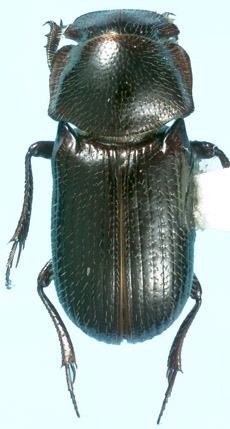 |
|||||||
|
|||||||
Euparia Saint-Fargeau and Serville 1828
Euparia Saint-Fargeau and Serville 1828: 357.
and Serville
Photo by Paul Skelley.
|
||
|
||
| Aphodiinae Overview | ||
| Eupariini Key |
Type species. Euparia castanea Lepeletier and Serville 1828: 357, by monotypy.
Diagnosis. Body length 4-5 mm, elongate, parallel-sided, reddish-brown, glossy, covered dorsally with fine setae. Head smooth, broad finely granulate at setal bases. Pronotum broad, sides explanate anteriorly; marginal setae hair-like. Elytral base with fifth interval prominent; fifth stria deeply grooved. Meso- and metatibia slender.
Distribution. S-USA to northern South America, W.Indies (Guadeloupe).
Composition. Euparia contains 3 species.
Euparia baraudi Chalumeau and Gruner 1974: 796, W.Indies (Guadeloupe).
Euparia castanea Lepeletier and Serville 1828: 357, Mexico, SE-US.
Euparia mirabilis (Balthasar 1945: 108) [Odontolytes], Venezuela, Suriname, Panama.
= Euparia bordoni Petrovitz 1963: 315.
Life History. Euparia castanea is a known associate with native fire ants (Solenopsis geminata (F.)) in the southeastern US. Comments on its biology appear in connection with studies on the red imported fire ant (Solenopsis invicta Buren) in the southeastern US (Wojcik et al. 1977a, 1977b, 1978). Euparia are occasionally collected at light.
Larvae. The larva of E. castanea is described in Ritcher (1966).
References:
Chalumeau, F., and H. F. Howden. 1984. Le genre Euparia (Coleoptera: Scarabaeoidea: Aphodiinae) Saint‑Fargeau and Serville, 1828. Mitteilungen der Schweizerischen Entomologischen Gesellschaft 57: 85‑94.
Ritcher, P.O. 1966. White grubs and their allies: A study of North American scarabaeoid larvae. Oregon State University Press, Corvallis, Oregon. Studies in Entomology 4: 219 pp.
|
||||
| Author: Paul Skelley Generated on: 08/MAY/08.....Last modified: 08/MAY/08 University of Nebraska State Museum - Division of Entomology |
